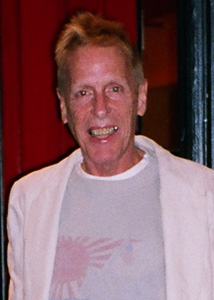 Author and journalist John Gilman was born in Honolulu, Hawaii. With his life partner Robert Heide, Gilman began writing the two-page centerfold for the Village Voice in the 1970s and, one thing leading to another, ended up as co-author of many pop culture books that focused on the Depression and Mickey Mouse. Gilman has also written a number of guidebooks with Heide.
Author and journalist John Gilman was born in Honolulu, Hawaii. With his life partner Robert Heide, Gilman began writing the two-page centerfold for the Village Voice in the 1970s and, one thing leading to another, ended up as co-author of many pop culture books that focused on the Depression and Mickey Mouse. Gilman has also written a number of guidebooks with Heide.
For author John Gilman, born in Hawaii, it turned out that his father’s profession would eventually become his as well. “My father was a well-known and well-regarded newspaperman,” he says. “He was in Shanghai writing about China for the International News Service when the Japanese starting bombing them. So he and my mother went to Hawaii, where he wrote for The Honolulu Advertiser. And they were there when the Japanese bombed Pearl Harbor!” This time the family stayed for quite some time. “I spent my first seven years on the beach at Waikiki where I swam before I walked.”
After the war, Gilman, along with his mother and brother, took a ship to San Francisco where John went to school, all the way from grammar school through college. “After that, I started taking trips to New York City where I would live for a while and then go back to San Francisco,” he says. “Finally, one day I was standing in Sheridan Square and made the decision to settle here for good. So I moved to the Village, met playwright Robert Heide at the Café Cino, and we became a couple. That was 1965.”
It was Gilman’s love of collecting “the things that nobody else wanted” that led to a string of books. “My being from California meant that Bob and I had a car in New York,” he says. “So we hit the highways, mostly in New Jersey, combing the flea markets and antique centers. Eventually the stuff we bought told us the story of the Depression. It was kind of a ‘made in America’ story because everything was made in America back then. That informed our first book, “Dime-Store Dream Parade,” which was about popular culture. Then we realized you’re only as good as your last book, so we did another one and then another. Along the way we acquired an agent and by the time we finished we had written fifteen books together. At the same time, we were doing magazine and newspaper articles as well. We were busy!”
“When I say ‘we’ I mean our bylines,” Gilman continues. “We stuck with Robert Heide first because he had a very good touch in terms of his writing. They were nonfiction books, but Bob brought a human element to them. I was a wiz at gathering the facts, so while our books were fun to read, they were also good references for the period they were covering.”
What appealed to Gilman most about his research? “We discovered that in the ‘30s every company hired industrial designers to redesign their products in a streamlined, modern style, using new materials such as plastic,” he says. “Our books are about how those new products were merchandised—the way America pulled up its boots straps by merchandising everything in a positive, can-do way. We looked at the cheerful side of the Depression, if you will. We covered the dark side, too, but what we tried to do was emphasize the good parts. We discovered it was a very creative and upbeat decade.”
When Gilman moved to New York in 1965, some vestiges of an earlier time still existed. “I remember very clearly when the cobblestones on Seventh Avenue were replaced by macadam,” he says. “I came out one day and the cars were whizzing by at a frightful speed. That was a big change! Bob and I miss the many coffee houses and the laid back, slow pace of the Village that used to be. But all of the amenities are at our fingertips here and it couldn’t be a better place to live. I know it’s crazy to say, but I think it’s the best place in America to live.”
Gilman also says he’s been noticing lately that commercial rents seem to be coming down. “That’s a good sign,” he says. “After all those high-end shops paying enormous rents closed up and left Bleecker Street for dead, we now see pop-up shops filling the spaces. Maybe the future will be bright. I look on the bright side of things anyway.” He laughs. “I’ve studied the Depression! If you were down in those days, you could go see a Busby Berkeley or a Mickey Mouse film. That’s because you knew you had to keep smiling.”
Photo: George Bonanno
